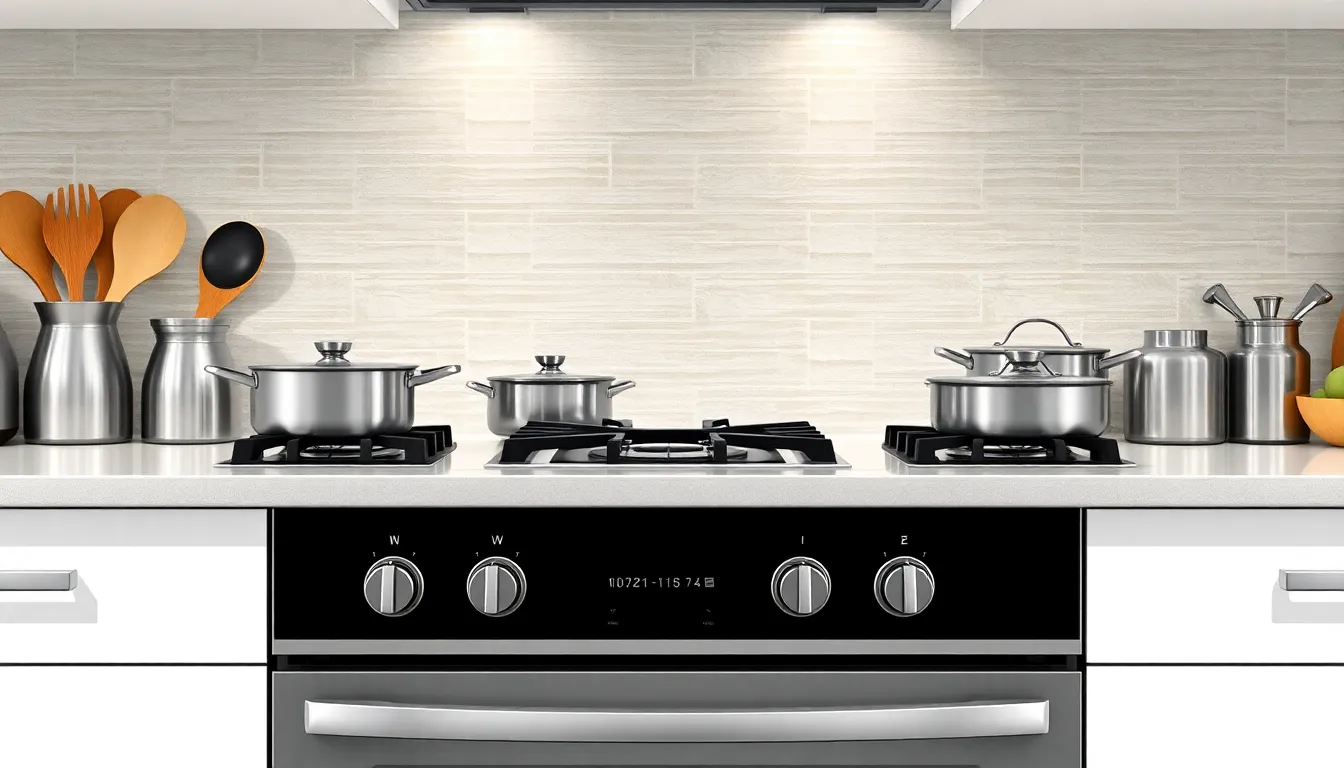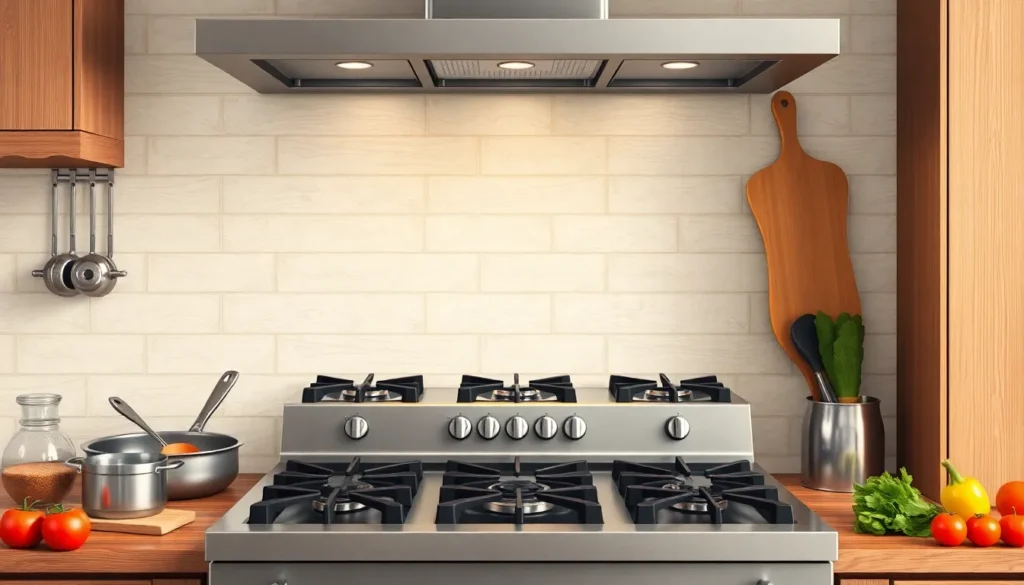Table of Contents
ToggleWhen it comes to culinary adventures, the gas stove reigns supreme, turning ordinary cooks into kitchen wizards. With its fiery flames and instant heat, it’s like having a mini dragon at your service. But what makes a gas stove truly special? It’s not just about the flames; it’s about the features that elevate cooking to an art form.
Overview of Gas Stove Features
Gas stoves incorporate several key features that enhance cooking efficiency and precision. Temperature control is one of the most notable. Chefs appreciate the instant response when adjusting flame levels, allowing for precise temperature management while cooking.
Burner configurations vary across models. Many gas stoves feature multiple burners with different sizes. This flexibility accommodates various pot sizes and cooking styles, making it easy to multitask.
Additionally, ignition systems differ. Electronic ignition offers an easier alternative to manual lighting, contributing to a safer cooking environment. Many modern gas stoves utilize a piezoelectric ignition system, ensuring reliable performance.
Safety features are essential in gas stove designs. Flame failure devices automatically shut off the gas supply if the flame extinguishes. This reduces the risk of gas leaks, providing peace of mind during use.
Materials and finishes also impact gas stove functionality. Stainless steel surfaces resist staining and offer durability over time, making them a popular choice. Enamel-coated surfaces can ease cleaning, providing a sleek and functional design.
Efficiency ratings often guide consumer choices. The most efficient models reduce gas consumption while delivering high performance. Researchers and manufacturers provide data showing these models can save up to 30 percent on energy costs compared to older stoves.
Finally, advanced features enhance the overall cooking experience. Some gas stoves come equipped with convection ovens, broilers, or integrated grills. These features expand culinary possibilities, allowing for diverse cooking techniques.
Types of Gas Stoves

Gas stoves come in various types, each designed to meet different cooking needs and preferences. Understanding the distinctions helps in selecting the ideal model.
Natural Gas Stoves
Natural gas stoves connect to a home’s gas supply, providing a steady and cost-effective fuel source. These stoves often feature multiple burners, allowing simultaneous cooking at different flame levels. Efficiency remains a significant advantage since natural gas typically costs less than electricity. Many models include advanced ignition systems that enhance safety and reliability. Natural gas stoves usually operate without interruptions, ensuring a consistent cooking experience. Homeowners will find that these stoves also require proper ventilation due to combustion gases.
Propane Gas Stoves
Propane gas stoves operate on propane tanks, making them suitable for homes without natural gas access. These stoves deliver high heat output, ideal for quick cooking or achieving precise sears. Flexibility in placement exists since propane tanks are portable, allowing for outdoor use. Many propane models are designed for easy ignition and offer adjustable burner configurations. Compatibility with various cookware ensures versatility in cooking methods. Additionally, propane is known for its clean-burning properties, which contribute to a healthier cooking environment.
Key Features to Consider
Gas stoves come equipped with a variety of features that significantly enhance the cooking experience. Understanding these features helps consumers make informed choices.
Burner Types and Efficiency
Different burner types impact cooking performance and energy efficiency. Standard burners deliver consistent heat, while high-output burners provide intense heat for techniques like searing. Simmer burners, designed for low heat, maintain delicate sauces without boiling over. Efficiency ratings of gas stoves range from 70 to 90 percent. Models showcasing a higher rating often promise substantial energy savings, specifically up to 30 percent.
Control Options
Control options vary widely among gas stoves, influencing cooking precision. Many models feature knob controls for quick adjustments, allowing cooks to easily change flame levels. Touch controls offer a modern approach, providing smooth operation and clear visibility. Some advanced options include digital displays, enhancing user convenience. Integration with smart home systems is becoming common, enabling remote monitoring and control of cooking settings.
Safety Features
Safety features serve as essential components of modern gas stoves. Flame failure devices automatically shut off the gas supply if the flame extinguishes unexpectedly. Additionally, many stoves incorporate child locks to prevent accidental ignition. Automatic shut-off systems also enhance safety by turning off the stove after a designated period. These features provide peace of mind for users, especially in busy kitchens.
Design and Aesthetics
Design and aesthetics play a crucial role in selecting a gas stove. Sleek stainless steel finishes bring a contemporary look, while enamel-coated surfaces offer vibrant color options. Customizable designs allow for seamless integration into various kitchen styles. Burners positioned for optimal spacing enhance usability, providing easy access and maneuverability. Overall, the appearance of a gas stove contributes to its functionality and the kitchen’s overall aesthetic.
Advantages of Gas Stoves
Gas stoves offer several benefits that enhance the cooking experience. Precise temperature control allows chefs to quickly adjust heat levels, making recipes easier to execute. Versatile burner configurations support various pot sizes, accommodating multiple cooking styles simultaneously.
Safety features stand out, with many modern gas stoves incorporating flame failure devices. This technology mitigates the risk of gas leaks, putting safety first in kitchens. Electronic or piezoelectric ignition systems contribute to user convenience, ensuring quick and reliable start-ups.
Durability enhances usability, as stainless steel and enamel-coated surfaces make cleaning simple. Efficiency ratings provide insight into energy savings, with certain models achieving up to 30 percent reductions in energy costs. Consumers often appreciate the additional financial benefits of gas stoves.
Advanced features bring culinary possibilities to life. Convection ovens offer even baking, while integrated grills enable outdoor-style cooking indoors. These functions expand options for both novice and experienced cooks.
Natural gas and propane models cater to distinct needs. Homes with natural gas benefit from a steady supply, while propane stoves suit spaces without direct access to gas lines. Portable propane tanks make it easy to cook outdoors, reflecting versatility.
Control options vary, presenting users with knob controls for quick adjustments or sleek touch controls for modern convenience. The design and aesthetics of gas stoves ensure they blend seamlessly into various kitchen styles. Customizable finishes enhance appeal, supporting individual preferences.
Considering these advantages makes gas stoves a valuable asset for home kitchens. Balancing efficiency, safety, and innovative features positions gas stoves as the top choice for culinary enthusiasts.
Maintenance and Care Tips
Regular maintenance enhances the lifespan of gas stoves. Cleaning the burners and grates should occur after each use, preventing food buildup. Wipe down the stovetop with a mild detergent and soft cloth to maintain a clean surface.
Inspecting the gas connections monthly helps identify any potential leaks. If there’s an unusual smell, turn off the gas supply immediately and ventilate the area, then contact a professional for assistance.
Checking the ignition system enhances safety. Ensure that the electronic or piezoelectric igniters function correctly. If the flame flickers or fails to ignite, it’s crucial to have it serviced.
Lubricating knobs and controls promotes smooth operation. Regularly apply a few drops of suitable lubricant to avoid any sticking or difficulty turning.
Replacing the burners when they show signs of wear increases efficiency. Burners can become clogged or rusted over time, which can affect performance.
Taking care of stainless steel and enamel surfaces requires gentle cleaning products. Use non-abrasive cleaners to prevent scratches and maintain the finish.
Finally, reviewing the user manual provides guidance specific to the gas stove model. Each model may have unique requirements for care and maintenance, ensuring optimal performance. Following these tips simplifies gas stove upkeep, enhancing both safety and functionality in the kitchen.
Gas stoves offer a blend of efficiency and versatility that can elevate any cooking experience. With features designed for precision and safety they cater to both novice cooks and seasoned chefs alike. The variety of models available ensures that there’s a perfect fit for every kitchen and every cooking style.
By understanding the unique features and maintenance needs of gas stoves consumers can make informed choices that enhance their culinary adventures. Investing in a quality gas stove not only simplifies cooking but also brings joy and creativity to the kitchen.







